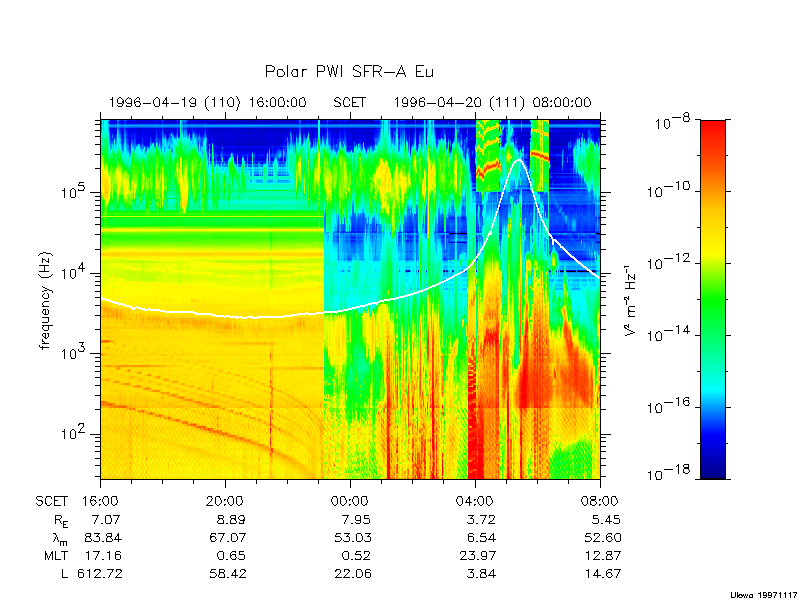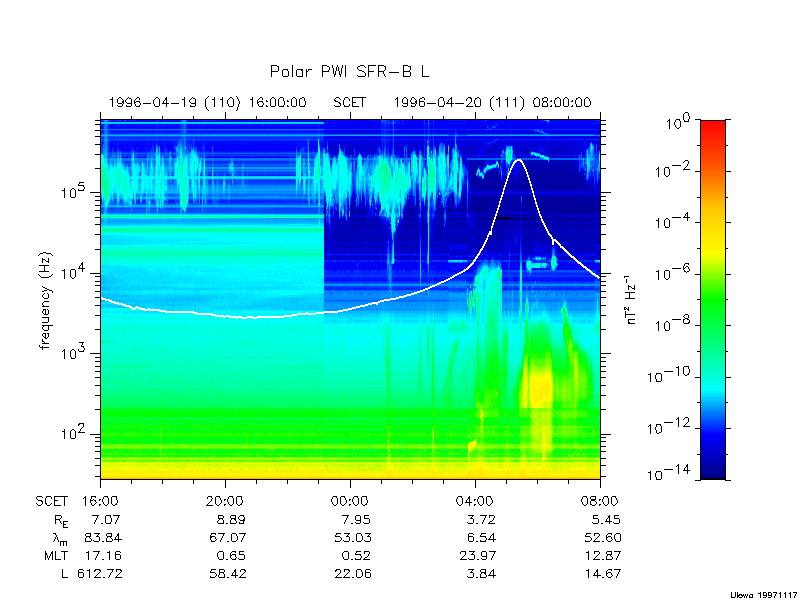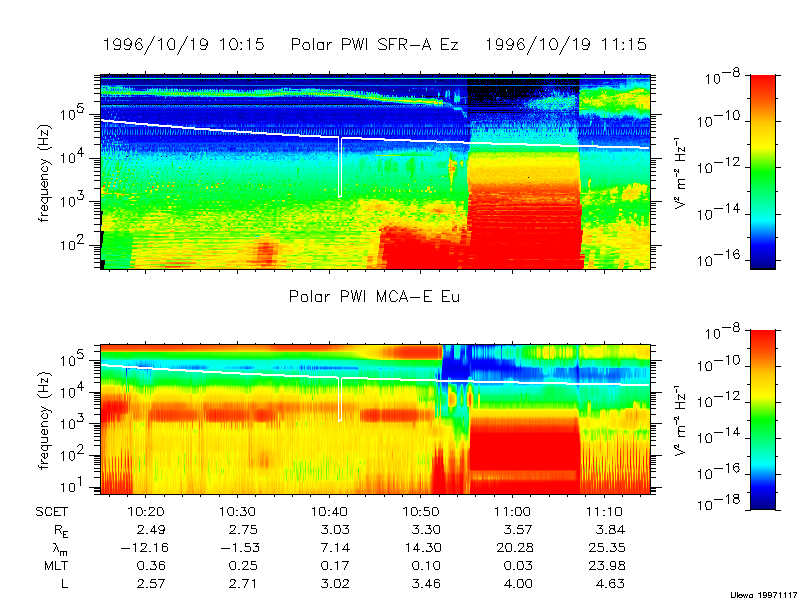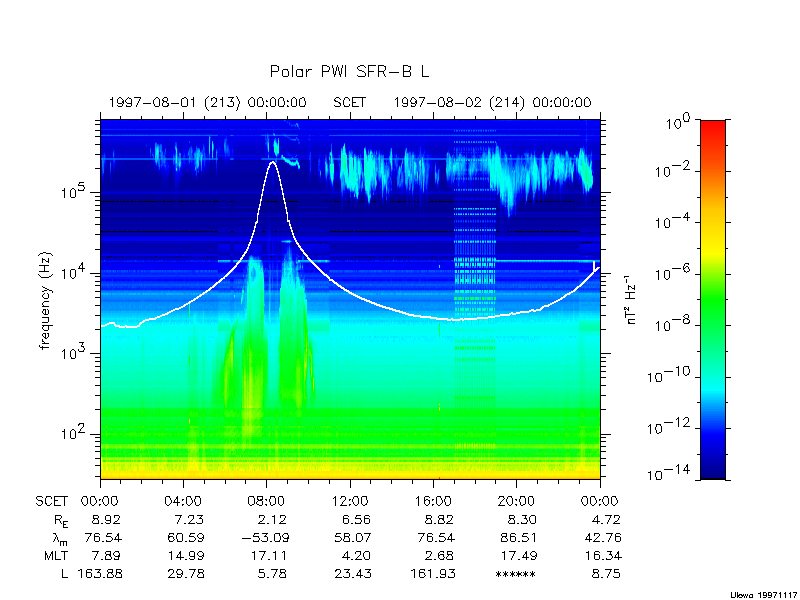In certain regions of the orbit and during certain planned operations, interference from other instruments and/or spacecraft systems affects the PWI measurements. At these times, e.g., during spacecraft eclipse, during Eu/Ev antenna preamplifier oscillation (low L), during PSI operations, one must use caution so as not to misinterpret the PWI data. The remainder of this page will be devoted to a description of the interference with examples of how it is manifested in the PWI data. If you need further information on these issues, please contact Jolene Pickett, project manager, at: pickett@uiowa.edu.
The Electric Field Instrument (EFI) interference was identified by the Polar EFI team as preamplifier oscillation in the Electric Eu and Ev antennas. The oscillation, which occurs at or slightly below the upper hybrid resonance frequency and its harmonics, are seen directly in the electric spectrogram (Figure 1) at about 0400-0440 and 0540-0620 UT on April 20, 1996, when the Sweep Frequency Receiver (SFR) was switched to the electric Eu antenna. As of this date, many aspects of the EFI interference are still not well understood. Some analysis was done in conjunction with the EFI Principal Investigator in an attempt to distinguish the "natural" from the "purely interference-produced" phenomenon in the PWI data. This analysis was discontinued after it became apparent that the EFI preamplifier oscillation effects were very complex, and were due to hardware design deficiencies which could not be modified or circumvented. In summary, during the approximately one hour or less centered on the lowest L-shell values of the Polar orbit (twice per orbit), almost all PWI data taken with the electric and loop antennas is contaminated with preamplifier oscillation effects, whether directly or through crosstalk or coupling, and is regarded as uninterpretable at this time. Note that the white line identifies the electron cyclotron frequency (fce), which is determined from the local magnetic field measurement.

The PWI data clearly show some effects of Polar Plasma Source Instrument (PSI) interaction as seen in Figure 1 and Figure 2 at hours 16 to 23 on April 19, 1996. In the case of both the electric and magnetic spectrograms, the intensity level of the measured signal is enhanced by greater than one order of magnitude at frequencies below about 40 kHz when the PSI is releasing gas. Although some operating modes of PSI have been found to cause a lesser effect on PWI measurements, none of these modes allows us to obtain measurements of the undisturbed plasma at all frequencies during the releases. Note that the white line identifies the electron cyclotron frequency (fce), which is determined from the local magnetic field measurement.

During the fall 1996 eclipse period we discovered that the EFI antennas were acting abnormally near the end of the rather lengthy eclipses. Figure 3 shows an example of this on October 19, 1996. The eclipse period started at 1018 UT and ended at 1107 UT. The extremely abnormal data occur only from about 1046 UT to 1107 UT, although small effects are seen in the electric data as soon as the spacecraft enters eclipse. The PWI electric field measurements taken during the approximate 5-10 minute periods near the end of eclipse are considered uninterpretable. It is thought that the abnormal wave signatures are caused by a combination of two things, 1) shadow effects on the antennas due to eclipses, and 2) the interaction of the shadow effect with the oscillation problem described above. The last few minutes of the mid-October 1996 eclipses occur in a portion of the orbit in which the antenna preamplifier oscillations are normally seen. The magnetic loop and search coil do not appear to be adversely affected by the spacecraft being in eclipse. Therefore, the data from these antennas are considered good. Note that the white line identifies the electron cyclotron frequency (fce), which is determined from the local magnetic field measurement.

In the magnetic calibrations mode, the receivers were configured as follows:
YYDDD DATE CAL ON CAL OFF
97210 July 29 1730 UT 1830 UT
97213 August 01 1700 UT 1900 UT
97216 August 04 1600 UT 1800 UT
97219 August 07 1400 UT 1600 UT
97221 August 09 1930 UT 2030 UT
97222 August 10 1200 UT 1400 UT
97224 August 12 1800 UT 2030 UT
Figure 4 shows an example of the effect during the August 01 calibration, which occured between 1700 and 1900 UT. Note that the white line identifies the electron cyclotron frequency (fce), which is determined from the local magnetic field measurement.

The spacecraft undergoes a flip maneuver once every six months. For these 180 degree spin axis precession maneuvers, only thruster 10 is used for the precession and attitude trim, thrusters 5 and 8 for the spin trim. The precession maneuvers are performed in two segments, followed by attitude and spin trims, as required. The thrusters are fired continuously for a given number of pulses. Flip maneuvers were executed during the following times:
START STOP PULSES/SPINS DURATION
(secs)
April 16-17, 1996
Segment 1: 107:03:20:06 107:06:50:38 2100/2100 12632.0
Segment 2: 108:00:56:48 108:04:30:05 2143/2143 12797.4
Att. trim: 108:14:35:06 108:14:45:02 100/100 595.9
Spin trim: Not required.
October 17-18, 1996
Segment 1: 291:16:03:16 291:20:10:47 2470/2470 14851.1
Segment 2: 292:01:22:29 292:04:46:23 2040/2040 12234.1
Att. trim: 292:21:20:31 292:21:26:18 58/58 347.2
Spin trim: 292:21:52:20 292:21:52:31 --- 11
April 12-13, 1997
Segment 1: 102:10:00:00 102:13:47:28 2270/2270 13647.7
Segment 2: 103:01:00:00 103:04:50:09 2302/2302 13809.6
Att. trim: 103:17:10:00 103:17:15:29 55/55 329.5
Spin trim: 103:17:55:00 103:17:55:10 --- 10
donald-gurnett@uiowa.edu, project PI pickett@uiowa.edu, project manager